Howard J. Wolff, senior vice president of WATG, shares his insights on the luxury hospitality market.Â
In the March issue of HD, we printed an excerpt from Howard Wolff’s Hotel Yearbook 2010 article, Luxe in Flux. Here is the full article from the senior vice president of WATG. For more on this topic, listen to Wolff and other industry experts at a panel with the same name, May 19th, during the 2010 Hospitality Design Exposition & Conference (HD Expo) in Las Vegas.
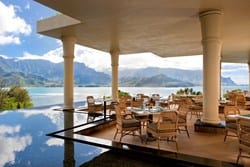 Luxury hospitality has been hit harder by the worldwide financial disruption than any other segments of the hotel business. It follows, therefore, that it is likely to take awhile for this sector to recover.
Luxury hospitality has been hit harder by the worldwide financial disruption than any other segments of the hotel business. It follows, therefore, that it is likely to take awhile for this sector to recover.
Some will simply wait for affluent travelers to return. Others say things will never be the same. Either way, there are some trends emerging that can help guide us through this fog of uncertainty.
Simon Cooper, president of The Ritz-Carlton Hotel Company, is one of many whose near-term plans assume a rebound: “When home prices stabilize, the stock market stays bullish and jobs are created, there will be a large amount of pent-up demand to travel.” A recent consumer survey corroborated this trend, suggesting that travel is an area in which people expect to indulge. However, others are more cautious-like president and CEO of the Leading Hotels of the World, Ltd. Ted Teng-expecting that the current difficult business environment will persist through 2010.Â
While all indications are that affluent travelers will indeed return eventually, what they will be hoping to find in the hotels and resorts they visit will have morphed in a number of subtle ways. Shifting perceptions about luxury will account for changes that we will see in high-end hospitality.
The changing nature of luxury
What sets apart the most recent financial crisis is its widespread and possibly lasting influence that seems to be occurring at every level-from surface to soul. Sonu Shivdasani, chairman and CEO of Six Senses Resorts & Spas, describes the genesis of the company’s “Intelligent Luxury” initiative: “I believe that this financial crisis has been a catalyst for a more general movement of change that is about reconsidering our values and our priorities, and changing the way we do things.”
To the extent that conspicuous consumption and ostentatious décor might be considered bad form in a global recession-where so many people and businesses have been hard hit-design aesthetics will be tamped down in new and recently renovated properties, thereby changing the look and reconsidering the definition of luxury.
Nevertheless, Mandarin Oriental Group chief executive Edouard Ettedgui believes that, “Whether in boom times or recession, the ability to provide exceptional and consistent quality facilities and service will remain the focus for each of our operating hotels.”
Others agree about the need to stay focused. Teng, of The Leading Hotels of the World, believes that some brands in the luxury sector will actually benefit from the shift in the marketplace … but not by slashing rates, amenities and staff. “The key to success is to remain focused on the organization’s values and be able to deliver on the brand promise, despite market conditions.”
While luxury conjures images of excess and indulgence, Isadore Sharp, founder, chairman and CEO of Four Seasons Hotels and Resorts, views it as something that goes deeper than aesthetics: “For our guests and clients, luxury is about making the most of their precious time. It’s about feeling welcomed and recognized. It’s about not having to worry about a thing.”      Â
Conscientious consumption
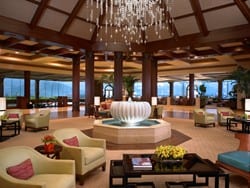 Among affluent travelers, there seems to be a general self consciousness about the appearance of over-indulgence and a desire to feel vindicated in some way. Shivdasani, of Six Senses, identifies the shift as “a move away from conspicuous consumption to conscientious consumption.”
Among affluent travelers, there seems to be a general self consciousness about the appearance of over-indulgence and a desire to feel vindicated in some way. Shivdasani, of Six Senses, identifies the shift as “a move away from conspicuous consumption to conscientious consumption.”
In other words, bling has blung. When it comes to luxury hotel design in 2010 and beyond, expect to see less flash and more substance; comfort over coolness; friendliness over pretentiousness.
Though clearly a 5-star brand, St. Regis recently went through the conversion of a property in Princeville, on the island of Kauai, that involved removing tons of polished marble, ornate railings and chandeliers, European themed furniture and artwork, and gilded Corinthian columns. Designers repositioned the Hawaii property to reflect its locale through the use of indigenous materials, paintings and sculpture by local artists, and custom-designed carpets and furnishings with a residential feel that exudes warmth and hospitality.
In 2010, polished brass and shiny chrome will be out. Natural stone and salvaged wood will be in. Recycled materials and accessories will enhance the guest experience and give a property a unique story to tell.
The recently opened Rough Luxe boutique hotel, in a London townhouse, illustrates this trend. “Luxury is about appreciating the provenance of an item and its unique qualities,” says Rabih Hage, the hotel’s local architect. The design incorporates layers of the property’s history from different periods and an eclectic collection of furniture from previous owners. Its very name encapsulates this emerging paradoxical trend.
Value is invaluable
For even the wealthy traveler, value will be a top priority, with branding taking a backseat in the coming years. The fact that consumer spending, even on sale items, will continue to be replaced by a reason-to-buy at all, spells trouble for brands with no authentic meaning, whether high-end or low.
“People want value for their money in every single market,” states Ralph Toledano, chairman and CEO of Chloé in Paris. Affluent travelers will be looking for an optimal price/quality balance when they are selecting their luxury vacation.
That suggests that luxury hotel and tour operators will thrive if they can demonstrate why it’s worth paying a bit more for an extraordinary experience.
To Isadore Sharp, real value is not about offering reduced room rates but rather it is about delivering “service that is consistent, reliable and tailored to each guest’s individual needs.”Â
Authenticity is for real
Moving away from the day when themed architecture transported guests to another place and time, new projects suggest a move toward a more natural hospitality environment. According to Thomas Storey, president of Fairmont Hotels & Resorts, “People are choosing authenticity over glamour and experiences over acquisitions.”
 Bonnie Knutson, professor at Michigan State University School of Hospitality Business suggests that “Old Luxury” was about things, whereas “New Luxury” is about experiences, feelings and memories.
Bonnie Knutson, professor at Michigan State University School of Hospitality Business suggests that “Old Luxury” was about things, whereas “New Luxury” is about experiences, feelings and memories.
That sentiment is echoed by Ritz-Carlton’s Simon Cooper: “To bring back the luxury customer, our industry will need to do more than add trappings and over-the-top amenities. We will have to ensure top-tier prices are equaled by truly memorable experiences.”
Decades ago, WATG lost a commission to renovate the venerable Raffles Hotel, in Singapore, because company founder Pete Wimberly refused the owner’s request to replace the iconic ceiling fans with central air conditioning in the guestrooms. Holding steadfast to his principles, Pete was less concerned about energy cost implications in 1988 than he was with preserving the authenticity of the place. While it’s doubtful many architects and designers would turn down work these days, for Pete it was about protecting the soul, the character, the uniqueness of a property.
Now, more than ever, there is a desire and an appreciation for cultural authenticity and for destinations with a sense of place.
Fairmont’s Thomas Storey seeks to provide guests direct opportunities to connect with the people and the place where their properties are located. “It is up to us as hoteliers,” he says, “to be creative and design adventures embroidered with the classic comforts that today’s luxury travelers appreciate. Whether it’s a chef’s rooftop garden where guests enjoy tea with lavender honey harvested from our own beehives, or working with National Geographic to lead guests on a safari tour with one of the world’s great photographers, we seek to provide rich experiences that are a true reflection of the land and local culture.”
Green is (here for) good
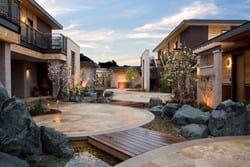 To some degree , green design has been about being altruistic-do what is right because it is right-but respecting the environment has been shown to make sense financially as well and will continue to gain traction in the luxury sector.
To some degree , green design has been about being altruistic-do what is right because it is right-but respecting the environment has been shown to make sense financially as well and will continue to gain traction in the luxury sector.
Some of this momentum is coming from travelers themselves, who are, according to Storey of Fairmont, “increasingly aware that some of the world’s most naturally spectacular environments are luxuries that need to be protected if we are to share them with our children and generations to come.”
Bardessono, a boutique hotel in Napa Valley, California, illustrates how luxury and green can go hand-in-hand. Designed to LEED Platinum standards, the property uses solar and geothermal energy, sophisticated energy management systems, sustainable building materials, and organic landscape management practices. Developer Phil Sherburne credits the green aspects of the design with providing a distinctive edge and getting him through the challenge of opening a luxury property in the midst of an economic downturn.
Guests like having a story behind their stay. Sharing “what makes it green” is one way to tell a story and to brand and differentiate a property.
Green also refers to “eco-luxury travel,” which is asserting its place in the luxury travel market. Based on WATG’s current portfolio of design commissions around the world, 2010 will see a continued rise of intimate, sustainable, villa resorts in eco-friendly destinations.
Many luxury hotel companies see the coming years as an opportunity to redouble their commitments to caring for the communities in which they work. “True luxury,” according to Raymond Bickson, managing director for Taj Hotels Resorts & Palaces, “encompasses authentic stewardship for the people and places we do business.” For Taj, this translates into investing 40 percent of its profits back into both rural and urban communities.
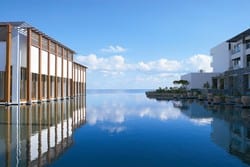 Respecting rather than rejecting the past
Respecting rather than rejecting the past
New and newly renovated hotel properties will have noticeable references to the past, designed in a contemporary manner. For Taj’s Bickson, “Luxury moves ahead best by respecting the past.”
The days of overpriced, undersized, trendy hotels are numbered. Timeless will trump trendy in the future, as hoteliers will seek to avoid the pressure to refresh their properties every year, lest they go out of fashion. Hotels that start with a bit of history can gain an edge over their competitors in this increasingly crowded landscape.
Case in point: One of the fastest growing hotel groups in Greece (and all of Europe), Grecotel is systematically and steadily expanding its portfolio of 4- and 5-star luxury properties by renovating and enhancing existing hotels with a contemporary nod to their historic past. The properties are not only a hit with guests, they also have been recognized with over 150 industry accolades and design awards.
Experience beats extravagance
This shifting definition of luxury, away from extravagance and toward experience, is captured by Geoffrey Kent, founder, chairman, and CEO of Abercrombie & Kent.
In describing what his customers are looking for, Kent suggests, “Our guests are searching for authentic experiences that are true to a place and its traditions, incorporating elements of the past and reflecting the local culture. They don’t want to simply arrive at a destination and look at things; they want to learn from local experts with an intimate, lifelong knowledge of the area and leave with a new understanding of how life is lived in another part of the world. This is travel for people who define luxury not so much by the degree of elegance but by the quality of experience.”
The opportunity to immerse oneself in an authentic environment can also take a more dynamic form, as it does in the growing arena of luxury adventure travel, appealing to those who are seeking above-and-beyond experiences in exciting new destinations. Some of these offerings will actually compete with traditional high-end hotels: niche boat cruises, exclusive safaris, and luxury destination clubs.
Emanuel Berger, CEO of The Victoria-Jungfrau Collection, speaks of authenticity as “a genuine experience of genuine hospitality.” According to Berger, “Spending valuable time with a partner and the family in a meaningful way, meeting interesting people, absorbing the local culture, experiencing the authenticity, inspiration and contextual sustainability-these are the new luxury goods of tomorrow.”
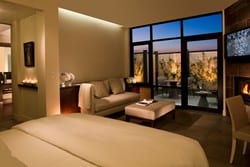 Luxury won’t go out of style
Luxury won’t go out of style
Many in the industry align themselves with Simon Cooper of Ritz-Carlton in hoping that, as early as this year, “we will see the perception of luxury as a negative begin to change.”
Adrian Zecha, founder of Amanresorts, predicts with confidence that “the top of the market will always be there.” Even so, he acknowledges that recovering from decreased revenues will continue to be a challenge in 2010.
There is little doubt that customers of high-end hotels and resorts will still want to experience luxury, but, according to Cooper, “their willingness to pay for it depends upon a return of consumer confidence.” Ted Teng thinks the luxury sector will return to its roots by catering to a clientele more immune to volatile economic conditions, rather than the recently widened approach designed to appeal to aspirational consumers, who have, for the moment, disappeared.
Some of those who have disappeared fell prey to the global slump in property and equity markets that cut the number of millionaires by 15 percent to 8.6 million, wiping out two years of increases, according to a survey by Capgemini and Merrill Lynch & Co. And the value of the world’s millionaires’ assets slid 20 percent to $32.8 trillion, according to that same survey, conducted in mid-2009. The good news is that several sources predict a boost in the number of millionaires in 2010 as well as an increase in their wealth and an enhanced propensity to spend.
  Â
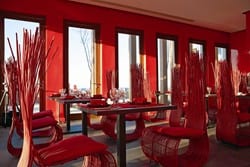 Lavish spending in some segments of the luxury sector already points to such a return. In the world of accessories, for instance, if you can offer something exciting, price is not a problem.
Lavish spending in some segments of the luxury sector already points to such a return. In the world of accessories, for instance, if you can offer something exciting, price is not a problem.
In terms of travel choices, however, conspicuous consumption and bragging rights may no longer be the motivators they once were. Ted Teng sums it up when he says that elite clientele will become even more discerning, but in slightly different ways: “Customers will increasingly be seeking value, quality, authenticity and personalized enriching experiences.”
The luxury hoteliers who succeed in 2010 and beyond will heed these trends and position their properties accordingly.
Pictured from top: St. Regis Princeville terrace, St. Regis Princeville lobby, St. Regis Princeville suite, Bardessono courtyard, Grecotel Amirandes, Bardessono guestroom, Grecotel Amirandes Thai restaurant


